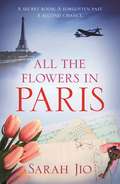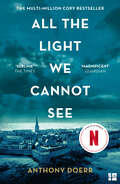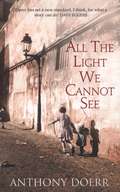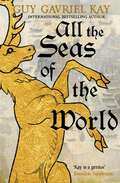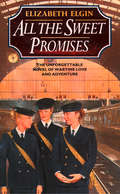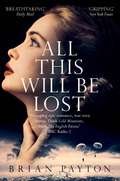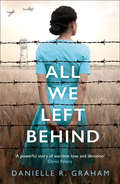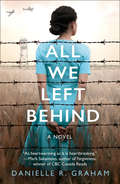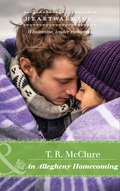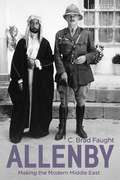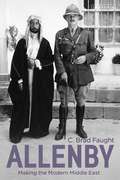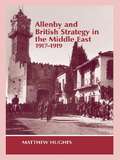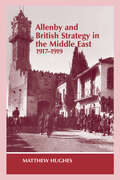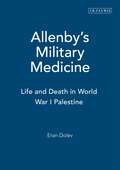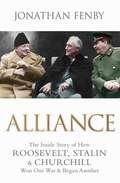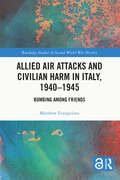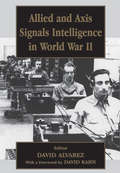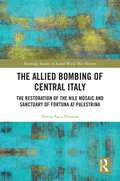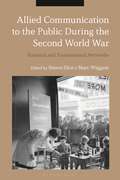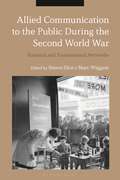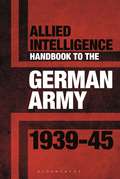- Table View
- List View
All the Flowers in Paris: The most heartbreaking new WW2 novel from international bestselling author you'll read this year
by Sarah JioLove burns brightest in the darkest timesWhen Caroline Williams wakes up in Paris with no memory of her past, she finds that returning to the life she has forgotten is harder than she thought. Even her cavernous apartment on rue Cler seems to hold no clues...As she searches, Caroline discovers a hidden stack of letters written by a young mother, Céline, during the Second World War. Captivated by Céline's desperate love for both her daughter and her missing lover, and the haunting glimpses of Paris under Nazi occupation, Caroline begins to realise she may have more in common with Céline that she could ever imagine.What dark secrets are harboured within the walls of her picture-perfect Parisian home? And could uncovering the truth about Céline unlock Caroline's own...?The compelling and evocative new historical novel from the international bestselling author Sarah Jio. Perfect for fans of The Key by Kathryn Hughes, The Parisians by Marius Gabriel and The Paris Secret by Lily Graham.
All the Light We Cannot See: A Novel
by Anthony DoerrWINNER OF THE 2015 PULITZER PRIZE FOR FICTIONNATIONAL BOOK AWARD FINALISTNEW YORK TIMES BESTSELLERWINNER OF THE CARNEGIE MEDAL FOR FICTION A beautiful, stunningly ambitious novel about a blind French girl and a German boy whose paths collide in occupied France as both try to survive the devastation of World War II
All the Light We Cannot See (PDF)
by Anthony DoerrA beautiful, stunningly ambitious novel about a blind French girl and a German boy whose paths collide in occupied France as both try to survive the devastation of World War II Marie-Laure has been blind since the age of six. Her father builds a perfect miniature of their Paris neighbourhood so she can memorize it by touch and navigate her way home. But when the Nazis invade, father and daughter flee with a dangerous secret. Werner is a German orphan, destined to labour in the same mine that claimed his father’s life, until he discovers a knack for engineering. His talent wins him a place at a brutal military academy, but his way out of obscurity is built on suffering. At the same time, far away in a walled city by the sea, an old man discovers new worlds without ever setting foot outside his home. But all around him, impending danger closes in. Doerr’s combination of soaring imagination and meticulous observation is electric. As Europe is engulfed by war and lives collide unpredictably, ‘All The Light We Cannot See’ is a captivating and devastating elegy for innocence.
All the Seas of the World
by Guy Gavriel Kay'Kay is a genius' Brandon Sanderson/font>Returning to the near-Renaissance world of A Brightness Long Ago and Children of Earth and Sky, international bestselling author Guy Gavriel Kay deploys his signature 'quarter turn to the fantastic' to tell a story of vengeance, power, and love.On a dark night along a lonely stretch of coast, a small ship, the Silver Wake, sends two people ashore to a stony strand. Their purpose is assassination. They have been hired to do this by two of the most dangerous men alive. The consequences will affect so many lives both great and small, and possibly alter the balance of power in the world.One of those arriving on that night strand is a woman abducted by corsairs from her home as a child, escaping that fate, that destiny, years after, now trying to chart her own course - and bent upon revenge. Another figure, on the boat, bringing it to meet the secretive landing party at the city where they are going, is a merchant who still remembers being exiled as a child with his family from their home, for their faith.Returning triumphantly to the brilliantly evoked near-Renaissance world of his most recent novels, international bestseller Guy Gavriel Kay deploys his signature 'quarter turn to the fantastic' to offer readers a wide-ranging, vividly memorable set of characters in a story of vengeance, power, and love, built around profoundly contemporary themes of exile, loss, and memory.In a narrative of page-turning drama, All the Seas of the World also offers moving reflections on choices, fate, and the random events that can shape our lives.
All the Sweet Promises (Isis Cassettes Ser.)
by Elizabeth ElginNow available as an ebook for the first time.
All Things Wise and Wonderful: The Classic Memoirs of a Yorkshire Country Vet (All Creatures Great And Small Ser. #3)
by James HerriotThe third collection of memoirs from the author who inspired the BBC series All Creatures Great and Small. Training as an RAF pilot in the smoke and bustle of London is a far cry from James Herriot’s day job as a country vet in the Yorkshire Dales. And while he is keen to serve Queen and country, James cannot help but miss his life in Darrowby – despite frequent arguments between his colleagues, bad-tempered cattle and equally irritable farmers, and the continuing saga of Cedric the flatulent dog. But most of all he misses his wife Helen; pregnant with their first child. The question is constantly hanging over him – will he be going to war? And when will he get to go home? Since they were first published, James Herriot’s memoirs have sold millions of copies and entranced generations of animal lovers. Charming, funny and touching, All Things Wise and Wonderful is a heart-warming story of determination, love and companionship from one of Britain’s best-loved authors.This omnibus edition comprises of Vets Might Fly and Vet in a Spin.
All This Will Be Lost
by Brian PaytonA stunning tale of love and survival against all odds, for fans of Cold Mountain. Published in hardback as The Wind Is Not a River.April 1943. In the bloody turmoil of war, John Easley, a journalist mourning his lost brother, is driven to expose a hidden and growing conflict: the Japanese invasion and occupation of Alaska's Aleutian Islands. But when his plane is shot down he must either surrender or struggle to survive in a harsh wilderness.Three thousand miles to the south, Helen Easley cannot accept her husband's disappearance-an absence that exposes her sheltered, untested life. Desperate to find and be reunited with him, she sets out on a remarkable journey from the safety of her Seattle home to the war in the north.An evocative, richly atmospheric tale of life and death, commitment and sacrifice, All This Will Be Lost, perfect for fans of Cold Mountain, is a gripping story of survival that illuminates the fragility of life and the fierce power of love.'Beautifully written, lyrical and elegiac, [this] is a novel you must read . . . John Easley's struggle to survive and his wife Helen's struggle to find him form the most triumphant and heartbreaking love story I've read in years' David Vann, author of LEGEND OF A SUICIDE
All We Left Behind
by Danielle R. GrahamFor fans of The Tattooist of Auschwitz ‘Heart-wrenching. Emotional. A powerful story of wartime love and devotion’ Glynis Peters, author of The Secret Orphan A powerful and incredibly moving historical novel inspired by an untold story of the Second World War.
All We Left Behind
by Danielle R. GrahamFor fans of The Tattooist of Auschwitz ‘Heart-wrenching. Emotional. A powerful story of wartime love and devotion’ Glynis Peters, author of The Secret Orphan A powerful and incredibly moving historical novel inspired by an untold story of the Second World War.
An Allegheny Homecoming: His Twin Baby Surprise An Allegheny Homecoming The Man She Knew With No Reservations (Home to Bear Meadows #2)
by T. R. McClureWhat happens when you do go home again?
Allenby: Making the Modern Middle East
by C. Brad FaughtEdmund Allenby, Viscount Allenby of Megiddo and Felixstowe, as he became later, was the principal British military figure in the Middle East from 1917 to 1919. He fulfilled a similar proconsular role in Egypt from the latter year until 1925. In these two roles Allenby's eight years in the Middle East were of great impact, and in probing his life an especially revealing window can be found through which to observe closely and understand more fully the history that has resulted in the terminal roil afflicting the Middle East and international affairs today. In this biography Brad Faught explores the events and actions of Allenby's life, examining his thinking on both the British Empire and the post-World War I international order. Faught brings clarity to Allenby's decisive impact on British imperial policy in the making of the modern Middle East, and thereby on the long arc of the region's continuing and controversial place in world affairs.
Allenby: Making the Modern Middle East
by C. Brad FaughtEdmund Allenby, Viscount Allenby of Megiddo and Felixstowe, as he became later, was the principal British military figure in the Middle East from 1917 to 1919. He fulfilled a similar proconsular role in Egypt from the latter year until 1925. In these two roles Allenby's eight years in the Middle East were of great impact, and in probing his life an especially revealing window can be found through which to observe closely and understand more fully the history that has resulted in the terminal roil afflicting the Middle East and international affairs today. In this biography Brad Faught explores the events and actions of Allenby's life, examining his thinking on both the British Empire and the post-World War I international order. Faught brings clarity to Allenby's decisive impact on British imperial policy in the making of the modern Middle East, and thereby on the long arc of the region's continuing and controversial place in world affairs.
Allenby and British Strategy in the Middle East, 1917-1919 (Military History and Policy)
by Matthew HughesExamines British military, political and imperial strategy in the Middle East during and immediately after the First World War, in relation to General Allenby's command of the Egypt Expeditionary Force from June 1917 to November 1919.
Allenby and British Strategy in the Middle East, 1917-1919 (Military History and Policy #No. 1)
by Matthew HughesExamines British military, political and imperial strategy in the Middle East during and immediately after the First World War, in relation to General Allenby's command of the Egypt Expeditionary Force from June 1917 to November 1919.
Allenby's Military Medicine: Life and Death in World War I Palestine
by Eran Dolev"Allenby's Military Medicine" examines a little-known feature of World War I as it was fought in the Middle East - the contribution made by the practice of military medicine to the success of Egyptian Expeditionary Force. In stark contrast with operations in the Boer War and some other First World War theatres of combat, which Eran Dolev describes as "medical disasters", the Palestine Campaign was marked by efficient and effective medical service. Dolev describes how this great achievement was inspired by General Allenby's uniquely attentive attitude towards the health of the troops and to military medicine. This is especially seen in the crucial area of fighting epidemic diseases like malaria, a major threat to a healthy fighting force at the time. Dolev also describes the general developments in military-medical organisation and surgery on the battlefield during these campaigns. The author's extensive and original research into military medicine is incorporated into an account of the campaign itself, demonstrating the degree to which the army's success depended on its medical support.The story of military medicine during the Palestine Campaigns is a story of exemplary relations between the command and the doctors in the field. The challenges they faced and their response constitute an exceptional chapter in the history of military medicine during the Great War.
Alliance: The Inside Story Of How Roosevelt, Stalin And Churchill Won One War And Began Another
by Jonathan FenbyThe history of the Second World War is usually told through its decisive battles and campaigns. But behind the front lines, behind even the command centres of Allied generals and military planners, a different level of strategic thinking was going on. Throughout the war the 'Big Three' -- Churchill, Roosevelt and Stalin -- met in various permutations and locations to thrash out ways to defeat Nazi Germany -- and, just as importantly, to decide the way Europe would look after the war. This was the political rather than military struggle: a battle of wills and diplomacy between three men with vastly differing backgrounds, characters -- and agendas. Focusing on the riveting interplay between these three extraordinary personalities, Jonathan Fenby re-creates the major Allied conferences including Casablanca, Potsdam and Yalta to show exactly who bullied whom, who was really in control, and how the key decisions were taken. With his customary flair for narrative, character and telling detail, Fenby's account reveals what really went on in those smoke-filled rooms and shows how "jaw-jaw" as well as "war-war" led to Hitler's defeat and the shape of the post-war world.
Allied Air Attacks and Civilian Harm in Italy, 1940–1945: Bombing among Friends (Routledge Studies in Second World War History)
by Matthew EvangelistaTens of thousands of Italian civilians perished in the Allied bombing raids of World War II. More of them died after the Armistice of September 1943 than before, when the air attacks were intended to induce Italy’s surrender. Allied Air Attacks and Civilian Harm in Italy, 1940–1945 addresses this seeming paradox, by examining the views of Allied political and military leaders, Allied air crews, and Italians on the ground. It tells the stories of a little-known diplomat (Myron Charles Taylor), military strategist (Solly Zuckerman), resistance fighter (Aldo Quaranta), and peace activist (Vera Brittain) – architects and opponents of the bombing strategies. It describes the fate of ordinary civilians, drawing on a wealth of local and digital archival sources, memoir accounts, novels, and films, including Joseph Heller’s Catch-22 and John Huston’s The Battle of San Pietro. The book will be of interest to readers concerned about the ethical, legal, and human dimensions of bombing and its effects on civilians, to students of military strategy and Italian history, and to World War II buffs. They will benefit from a people-focused history that draws on a range of eclectic and rarely used sources in English and Italian.
Allied Air Attacks and Civilian Harm in Italy, 1940–1945: Bombing among Friends (Routledge Studies in Second World War History)
by Matthew EvangelistaTens of thousands of Italian civilians perished in the Allied bombing raids of World War II. More of them died after the Armistice of September 1943 than before, when the air attacks were intended to induce Italy’s surrender. Allied Air Attacks and Civilian Harm in Italy, 1940–1945 addresses this seeming paradox, by examining the views of Allied political and military leaders, Allied air crews, and Italians on the ground. It tells the stories of a little-known diplomat (Myron Charles Taylor), military strategist (Solly Zuckerman), resistance fighter (Aldo Quaranta), and peace activist (Vera Brittain) – architects and opponents of the bombing strategies. It describes the fate of ordinary civilians, drawing on a wealth of local and digital archival sources, memoir accounts, novels, and films, including Joseph Heller’s Catch-22 and John Huston’s The Battle of San Pietro. The book will be of interest to readers concerned about the ethical, legal, and human dimensions of bombing and its effects on civilians, to students of military strategy and Italian history, and to World War II buffs. They will benefit from a people-focused history that draws on a range of eclectic and rarely used sources in English and Italian.
Allied and Axis Signals Intelligence in World War II (Studies in Intelligence)
by David AlvarezThe importance of codebreaking and signals intelligence in the diplomacy and military operations of World War II is reflected in this study of the cryptanalysts, not only of the US and Britain, but all the Allies. The codebreaking war was a global conflict in which many countries were active. The contributions reveal that, for the Axis as well as the Allies, success in the signals war often depended upon close collaboration among alliance partners.
Allied and Axis Signals Intelligence in World War II (Studies in Intelligence)
by David AlvarezThe importance of codebreaking and signals intelligence in the diplomacy and military operations of World War II is reflected in this study of the cryptanalysts, not only of the US and Britain, but all the Allies. The codebreaking war was a global conflict in which many countries were active. The contributions reveal that, for the Axis as well as the Allies, success in the signals war often depended upon close collaboration among alliance partners.
The Allied Bombing of Central Italy: The Restoration of the Nile Mosaic and Sanctuary of Fortuna at Palestrina (Routledge Studies in Second World War History)
by Teresa Fava ThomasThe Allied Bombing of Central Italy examines the results of the Second World War Allied bombing campaign on Palestrina and Rome, Italy, and the long-term impact of the war on the mountainside town and on the Barberini family's art collection including the Nile Mosaic. It explores the history and cultural significance of Palestrina, its strategic setting, the recovery of the town, the restoration of the Nile Mosaic, which remains the largest Egyptian-style mosaic extant. A unique aspect of the destruction was that it uncovered a pagan temple, the Sanctuary of Fortuna. The bombing destroyed the homes built on its terraces but revealed the ancient structure buried beneath which had remained unseen for half a millennium. It took more than a decade for the mosaic to be restored and the Sanctuary of Fortuna established as a national archeological museum. The book explores the pressure by the Mussolini regime to control the Barberini family's art collection, the uses of cultural materials for propaganda purposes, the Allied use of airpower in the Italian theater of war, the postwar decision-making and recovery process. The book is one of the very few long-range studies of the war's impact on a single Italian town. It is suitable for academic seminars and an educated general audience.
The Allied Bombing of Central Italy: The Restoration of the Nile Mosaic and Sanctuary of Fortuna at Palestrina (Routledge Studies in Second World War History)
by Teresa Fava ThomasThe Allied Bombing of Central Italy examines the results of the Second World War Allied bombing campaign on Palestrina and Rome, Italy, and the long-term impact of the war on the mountainside town and on the Barberini family's art collection including the Nile Mosaic. It explores the history and cultural significance of Palestrina, its strategic setting, the recovery of the town, the restoration of the Nile Mosaic, which remains the largest Egyptian-style mosaic extant. A unique aspect of the destruction was that it uncovered a pagan temple, the Sanctuary of Fortuna. The bombing destroyed the homes built on its terraces but revealed the ancient structure buried beneath which had remained unseen for half a millennium. It took more than a decade for the mosaic to be restored and the Sanctuary of Fortuna established as a national archeological museum. The book explores the pressure by the Mussolini regime to control the Barberini family's art collection, the uses of cultural materials for propaganda purposes, the Allied use of airpower in the Italian theater of war, the postwar decision-making and recovery process. The book is one of the very few long-range studies of the war's impact on a single Italian town. It is suitable for academic seminars and an educated general audience.
Allied Communication to the Public During the Second World War: National and Transnational Networks
by Simon Eliot Marc WiggamIn the Second World War, the home fronts of many countries became as important as the battle fronts. As governments tried to win and hold the trust of domestic and international audiences, communication became central to their efforts. This volume offers cutting-edge research by leading and emerging scholars on how information was used, distributed and received during the war. With a transnational approach encompassing Germany, Iberia, the Arab world and India, it demonstrates that the Second World War was as much a war of ideas and influence as one of machines and battles.Simon Eliot, Marc Wiggam and the contributors address the main communication problems faced by Allied governments, including how to balance the free exchange of information with the demands of national security and wartime alliances, how to frame war aims differently for belligerent, neutral and imperial audiences and how to represent effectively a variety of communities in wartime propaganda. In doing so, they reveal the contested and transnational character of the ways in which information was conveyed during the Second World War.Allied Communication during the Second World War offers innovative and nuanced perspectives on the thin border between information and propaganda during this global war and will be vital reading for World War II and media historians alike.
Allied Communication to the Public During the Second World War: National and Transnational Networks
In the Second World War, the home fronts of many countries became as important as the battle fronts. As governments tried to win and hold the trust of domestic and international audiences, communication became central to their efforts. This volume offers cutting-edge research by leading and emerging scholars on how information was used, distributed and received during the war. With a transnational approach encompassing Germany, Iberia, the Arab world and India, it demonstrates that the Second World War was as much a war of ideas and influence as one of machines and battles.Simon Eliot, Marc Wiggam and the contributors address the main communication problems faced by Allied governments, including how to balance the free exchange of information with the demands of national security and wartime alliances, how to frame war aims differently for belligerent, neutral and imperial audiences and how to represent effectively a variety of communities in wartime propaganda. In doing so, they reveal the contested and transnational character of the ways in which information was conveyed during the Second World War.Allied Communication during the Second World War offers innovative and nuanced perspectives on the thin border between information and propaganda during this global war and will be vital reading for World War II and media historians alike.
Allied Intelligence Handbook to the German Army 1939–45
by Stephen BullWhat did the British or American soldier know about the German Army? Was this knowledge accurate - and just how did he know it? There have been several 'handbooks' of Second World War armies, but they never tell us exactly what the Allied soldier knew at the time, or how he was informed. This is of importance because it influenced both conduct on the battlefield, and the way in which the soldier thought about his enemy. The book explains the background history of the organisations involved, followed by short chapters based around a series of original documents. This puts the original into context and also discusses whether the document that follows was correct in the picture it painted, and what can be deduced about sources and the concerns of the intelligence officers who compiled the material. Most of the documents were produced at the time, by the British War Office or US War Department, and cover different aspects of the German Army, including tactics, weapons, and uniforms. Subjects include: Allied intelligence on the German Army from 1930 onwards, British SIS / MI6 and US Military Intelligence. The organisations responsible, how they worked, and how they changed very rapidly with the coming of war. The role of technology, modern – like the radio transmitter, ancient – as in scouring libraries and periodicals, reports on military manoeuvres and parades. Limitations of 'Ultra' The German army itself, from the tiny force left after Versailles, to the rapid expansion in the late 1930s. Innovation in tanks, tactics, machine guns, rocket weaponry. The problems of gathering intelligence, not just danger, but finance, asking the right questions and the limitations of reporting and distribution.
